Posted by
Shay Harel
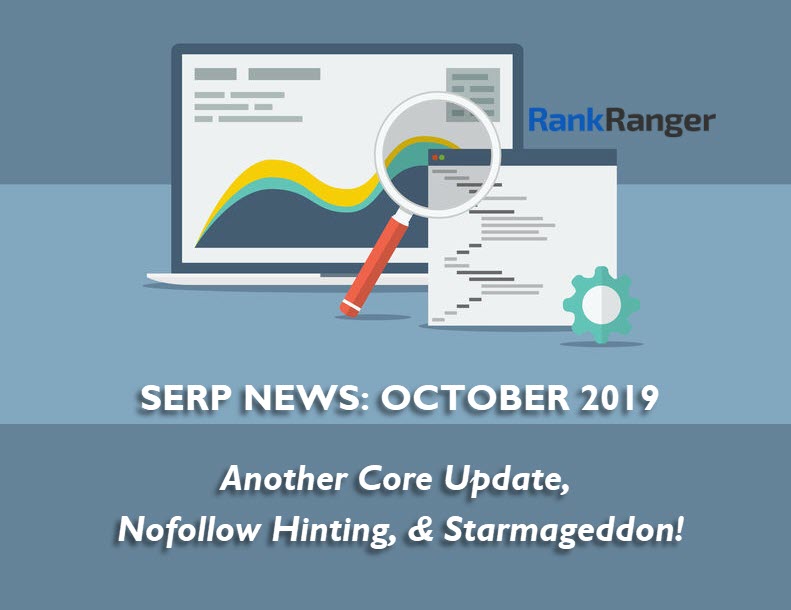
Growing up, my favorite sports announcer’s preferred catchphrase was ‘Holy cow’. Looking back at the Google SERP in September and all I can say is… Holy cow! Another core algorithm update landed, reviews on the SERP have tanked like an airplane made of lead, the nofollow attribute is no longer a directive, & original news reporting now ranks at the top of the SERP (or does it?)! Throw in an overhaul to Google’s Quality Rater Guidelines and… Holy cow!
Here are the juicy details!
The September 2019 Core Update Lands on the SERP
We almost got out clean. Other than a sizable unconfirmed update (more on that soon), September was not the worst month for rank fluctuations on the Google SERP. All that changed on September 24th when Google preannounced the September 2019 Core Update. (Yes, Google has taken to preannouncing core updates and pre-naming them as well.)
What’s interesting here is that the per the Rank Risk Index, the update began with mild increases in rank fluctuations, at least as core updates are concerned:

Moreover, and as you can see above, the update only lasted two days. By way of contrast, the June core update took three days to roll out, the March update unraveled over four days, and the Medic update hit the SERP for three days as well.
In terms of overall ranking impact, while every core update is significant, the data points to this one being a bit less potent than some of the other core updates we’ve seen. For example, when compared to the June 2019 Core Update this update almost pales in comparison:
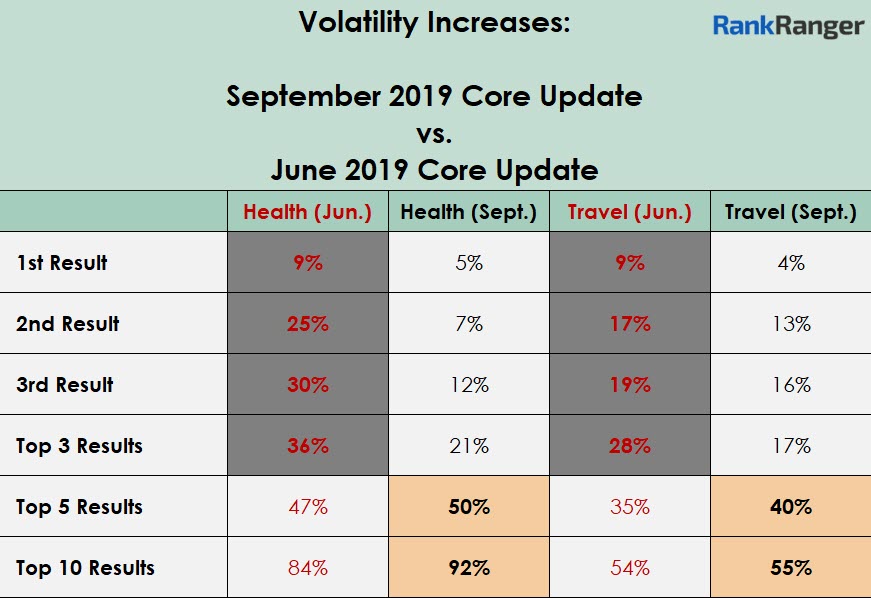
Don’t be fooled by the slightly larger volatility increases seen during the September update for the Top 5 and Top 10 Results metrics, the June update was far more impactful. Looking above, you can clearly see the large discrepancies between the volatility levels of the September and June updates. June had volatility increases at the top of the SERP that were in some cases not only double the volatility increases seen during the September update but triple the levels seen during the latest core update!
Don’t Forget September’s Unconfirmed Update
I’m all for not getting caught in the core update hype at the expense of unconfirmed Google updates. On September 18th, Google sent a shockwave through the system that resulted in a massive wave of rank fluctuations… despite it not being confirmed by the search engine.

The update initially began with a mixture is slightly high to moderate levels of rank fluctuations. By the 18th, though, the Rank Risk Index recorded significantly higher levels of fluctuations with a risk warning of 99. Significant… yet unconfirmed!
Starmaggedon Crashes Into the SERP as Reviews Disappear!
The rules of the ‘reviews’ game have changed. On September 16th, Google announced that self-serving reviews would not appear within your page’s organic result no matter how awesome your use of schema markup is.
And a self-serving review is what exactly?
Google defines a self-serving review as any review hosted on your site that is a review of your site/product/service. In other words, any review about you that you host on any page on your site. This applies to reviews you post yourself or bring on via a third-party integration. Such reviews can no longer be a part of your ‘rich result’ life on the SERP.
Google’s Danny Sullivan dubbed this change the September 2019 Review Rich Results Update. However, other than the official name being a bit too long for my taste, the impact of the change has resulted in the industry referring to this update as Starmageddon.
Unlike other “aggedons,” such as ‘mobilegeddon’, there is a legitimate reason to apply such a hyperbolic sort of name. Per our SERP Feature Tracker there was been a 7-point initial drop in the number of page one SERPs containing a review within the organic results. That reflects a 16% decrease.
By the time the month ended, there was a 14-point drop in reviews on the SERP, a 33% loss!

Concurrent to ‘Starmageddon’, the number of reviews on page one of the SERP dropped off significantly
At the same time, Google also announced that for a review to appear within an organic result, it must make use of the ‘name’ property within the structured data. That is, you must indicate the name of the product or service being reviewed.
Last but not least, Google released its official list of the schema that supports reviews within rich results!
Taking a Hint: The ‘nofollow’ Attribute Is No Longer a Directive
Throwing the SEO community into a tizzy, Google announced that the no-follow link attribute is now but a hint.
What in the world does that mean?
It means that Google may “follow” a no-follow link and consider it as part of your ranking profile. Let’s break this down a bit. As of March 2nd, 2020, Google may decide to follow a link despite it being ‘nofollow’ and as a result, may crawl and index the page to which you linked to. At the same time, and currently in effect, Google may consider a ‘nofollow’ link as part of your site’s/page’s “ranking equation.”
How do you know when Google will take the hint and consider your nofollow link as exactly that, “no follow?” You don’t. Any more brilliant questions?
Also, this announcement comes with two new link attributes:
- rel=”sponsored”: For when you’re linking to a site as a result of a sponsorship.
- rel=”ugc”: For when the links on your site have been placed there by users, as is common in a comments section.
The above is a bit of a sticky point. Google wants SEOs to use the new link attributes but has offered no incentive to do so since the new attributes will also be viewed as “hints,” not directives. Time will tell if SEOs will be “altruistic” and help Google refine their understanding of links on a page or if they’ll just stick to the ‘nofollow’.
Google Pushes Original Reporting to the Top of the SERP

If you are the breaker of news, Google will now reward you with top rankings. Google’s news algorithm has been updated to reward original reporting with better placement on the SERP. Over the past few months, Google has been tinkering with the algorithm so as to reward the originators of news with the rankings they deserve. On September 12th, Google announced the tweaking is done and the algorithm is ready to consistently reward original reporting.
I’ve tested this out myself I have seen the new change in effect in multiple instances.
That said, there has been a bit of controversy around the update.
Since Google’s announcement, multiple reports of original creators ranking below syndicated content have surfaced. Personally, I delved into dozens of queries only to find that the AP (Associated Press) does not rank on page one of the SERP for keywords that reflect the exact title of the articles they originally wrote for syndication. Rather, the AP’s syndicates rank instead. The reason for this is that Google has a hard time determining original reporting in cases where its creators do not use the rel-canonical tag and where the syndicates do use the rel-canonical tag to point to themselves as the original creators.
Google Revisits the Quality Rater Guidelines
Early September gave us a new version of the Quality Rater Guidelines (QRG), the first since May 2019… which is not really that long ago. Interestingly, the new guidelines call for considering ‘very high-quality main content’ to be “original” content. This is, of course, intriguing as the call for originality within the QRG came just days before Google announced its algorithmic preference for original news reporting. This is all the more fascinating as the changes to the guidelines heavily focused on news content. It would appear that there is room to call for a correlation between the algorithm and the QRG…. I realize that’s a controversial statement, I’m just not sure why such a notion is so contentious at this point!
Other changes to the guidelines include:
- A reorganization of ‘news’ content into new labels/titles with such content leading the YMYL category
- A focus on who wrote the content in terms of the site themselves writing it or the content being written by an outside source (i.e., a guest post, etc.)
- New criteria for high-quality video content
For a more detailed look at the changes, I highly recommend the SEM Post’s write-up as well as a post highlighting of the top 5 changes made to the QRG by Lily Ray of Path Interactive.
The SERP Roundup for September 2019
While not a month for a serious volume of changes to the SERP and its feature there were some blockbusters that hit the SERP in September. Thus, what Google lacked in volume it made up with substance.
Here we go!
Titles on the SERP Are Shorter
Big news if you think titles on the SERP are important, i.e., big news for everyone who does SEO… Google has cut the average number of characters that appear within titles on the SERP.
On September 7th, Google cut the average title down from 54.5 characters to around 51 characters. That can happen and has happened in the past so I wasn’t too concerned when I first saw the change. I figured Google would return title length averages to normal in a few days. It did not. For the time being, it appears that Google has settled on roughly 51 characters for its titles on the SERP.

On September 7th, Google reduced the average length of the titles shown on the SERP
(By the way, I’m well aware that titles work in pixels. Pixels are not as “clearcut” as characters, so we go with characters when reporting on these sorts of things.)
You can use Rank Ranger’s free SERP Feature Tracker to keep up with any further changes Google makes to title length.
‘In This Video’ Added to SERP Videos
Here’s a really snazzy one for you… an ‘In this video’ carousel for videos on the SERP!
And what’s that?
That’s Google taking the transcript of a YouTube video and entity/machine learning understanding the heck out of it.
In practical terms, this means that Google has dissected a video into its ‘subtopical parts” and has represented those subtopics within a carousel that appears underneath the video itself. That is, Google is showing a carousel that reflects the subtopics discussed in a video along with the time when those subtopics become relevant within the video.
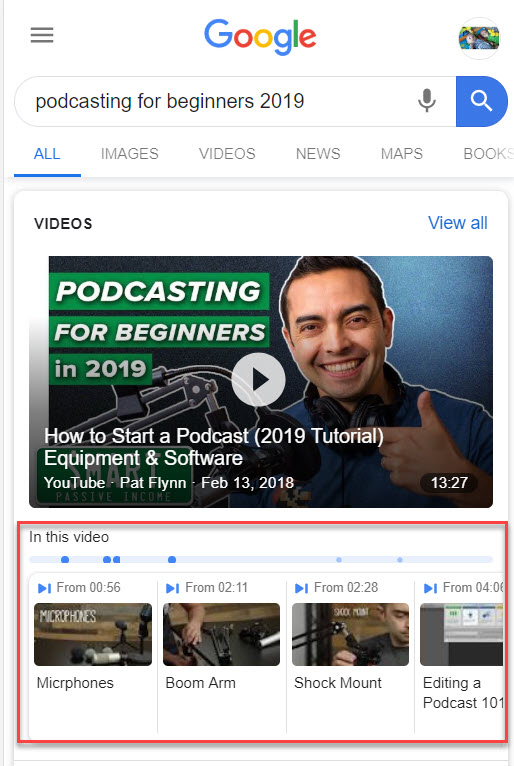
A video showing the ‘In this video’ carousel underneath it
Of course, users can use the carousel to easily move to the subtopic that speaks to them by clicking on a carousel card. Thus, the ‘In this video’ carousel makes searching and searching and searching within a video for the precise content you are looking for a thing of the past!
Sounds great, right? It is. It’s cool, it’s nifty, and it’s great for users. However, if you are promoting a sponsor at the onset of a video, this might not be so great for you. Just something to consider.
New Movie Carousel for the SERP & Movie Markup for Sites
Early September gave us a brand new in-depth way to access movie/TV show information without ever having to click on an URL. So if this sort of thing burns you inside, you might want to skip this… or not. That out of the way, for queries related to finding your next binge-worthy TV show, i.e., what to watch or good shows to watch, Google will give you an overlay that lets you swipe through and even “rate” all sorts of excuses to ignore your real life in favor of staring at a screen!
Here’s what Google offered me:
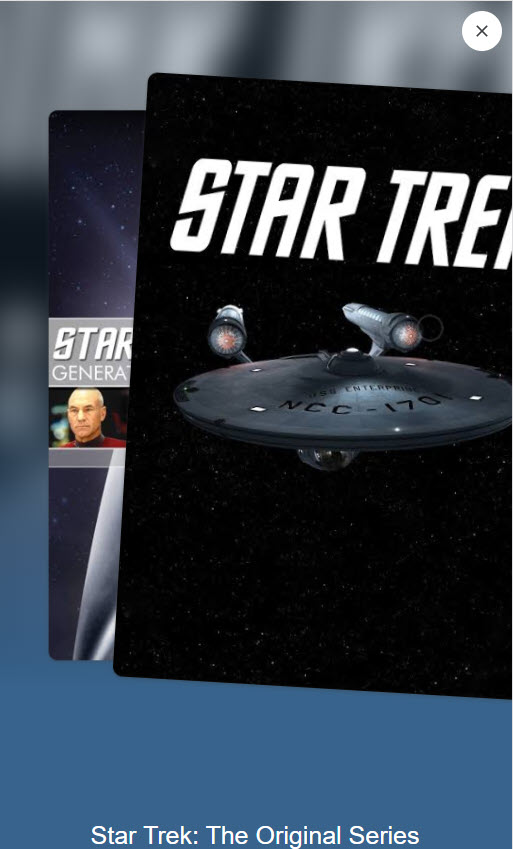
Google is calling it “Top picks for you” and as of now it only appears on mobile in the US.
At the same time, Google gave sites ranking organically a bone by offering structured data centered on showing movie details within their results. That is, you can offer Google details via schema markup such as a movie’s title and so forth. So there’s that.
Google Puts Webmasters in the Driver’s Seat with New Snippet Settings
Speaking of structured data, Google released controls to help webmasters manage the snippets that appear within rich results. Among the new controls are a tag that tells Google how long a video preview should last (you know, when you hover over a video thumbnail and you see a preview of the content) and a meta tag that tells Google the maximum length you would like a snippet of text to be.
Google Bans Bad Medicine in Google Ads
It looks like the YMYL focus on user safety has made its way to Google Ads. In specific, the search engine has invalidated ads that seek customers for “unproven and experimental” health products or services. This is, of course, interesting since it means Google knows what is and what is not “good medical science.” How it creates this understanding is something I spoke about in a recent episode of The In Search SEO Podcast.
More Cards in the News Carousel
Google has been testing an extra half of a card in the Top Stories Carousel!
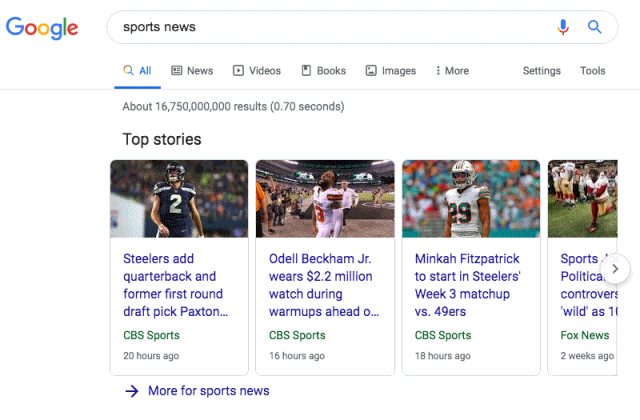
A Google test gave the Top Stories carousel an extra half of a card within the carousel’s initial showing (Image Source: SERoundtable.com)
Not excited by that? Well, it is actually important because it brings visibility to a new result that would have otherwise only been seen if the user chose to move through the news carousel. So, if you very much focus on the Top Stories carousel this could either bring you new visibility/clicks or it could mean new competition in already competitive vertical! See, every change to the SERP matters!
Bringing Search Results Into Focus
Rank Ranger’s very own founder, Shay Harel, caught an interesting test that had Google “highlighting” results. When hovering over a given organic result, Google was showing a vertical bar to the left of the result. The vertical bar brought the result a bit more into focus. While a limited test, such a feature helps make the SERP a bit more user-friendly.
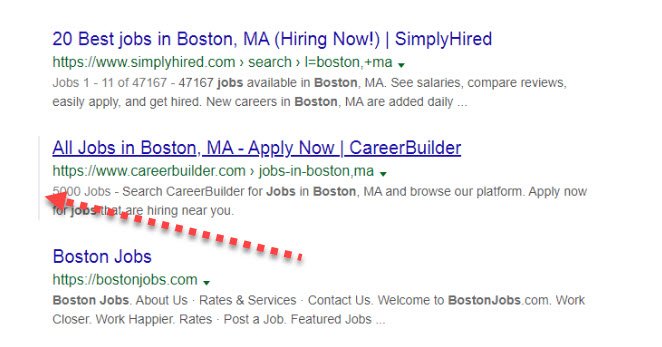
A September test produced a gray vertical bar when hovering over a result on the SERP
Hotel Panels Highlight Distance to Attractions
Yet another update to hotel results on the SERP. This time Google is showing the distance from a hotel to popular attractions near its location.
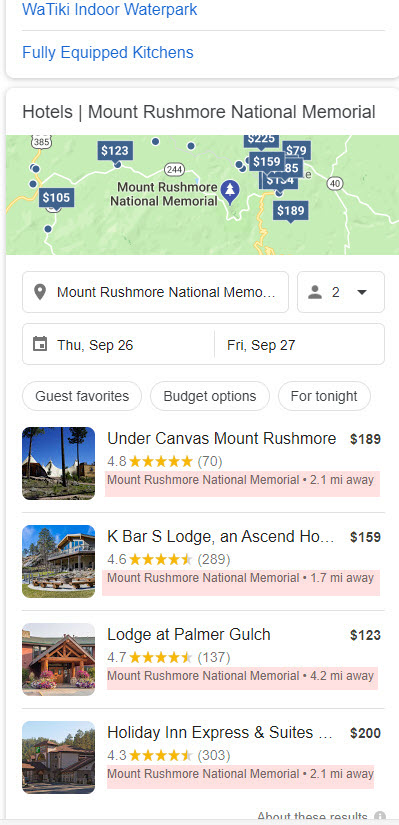
A Hotel Local Pack showing the distance from the listing to Mount Rushmore
Personally, that’s pretty helpful and could help hotels garner some more business… assuming they’re close enough to interesting attractions relative to the other hotels listed!
SERP Shakeups Are for Contemplation

The contrast is interesting. Usually, the ‘SERP News’ series focuses on more structural changes to the SERP and SERP features. September, however, really presented us with a Google that was honed in on altering the underbelly of the SERP and beyond. These are the moments to sit back and contemplate. To think about what the changes that Google has made signify. Why were they made? What does Google, other than the obvious theories proposed, gain from making the nofollow attribute a hint over a directive? Why does Google suddenly feel the urge to limit ‘self-serving’ reviews? If the update to the QRG aligns to the original reporting preference update what does that point to and perhaps signify? And of course, what do the latest core algorithm update patterns spell for the SEO industry?!
Like I said earlier, Holy cow!
Thanks for joining me this month! Catch the SERP News again when November rolls in for all-new updates to the Google results page!

